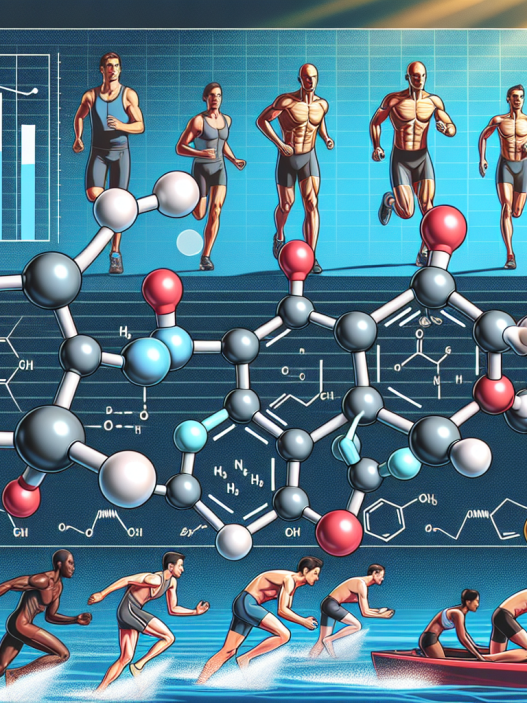-
Table of Contents
Delving into Testosterone Enanthate Side Effects in Sports
Testosterone enanthate is a synthetic form of testosterone, a naturally occurring hormone in the body responsible for the development of male characteristics. It is commonly used in sports to enhance performance and muscle growth. However, like any other medication, it comes with potential side effects that athletes and coaches should be aware of. In this article, we will delve into the side effects of testosterone enanthate in sports and provide evidence-based information to help athletes make informed decisions.
Pharmacokinetics and Pharmacodynamics of Testosterone Enanthate
Before discussing the side effects, it is important to understand the pharmacokinetics and pharmacodynamics of testosterone enanthate. This will help in understanding how the drug works in the body and how it may cause side effects.
Testosterone enanthate is administered through intramuscular injection and has a half-life of approximately 4-5 days (Nieschlag et al. 2012). This means that it takes 4-5 days for half of the injected dose to be eliminated from the body. The drug is then converted into dihydrotestosterone (DHT) and estradiol, which are responsible for its anabolic and androgenic effects, respectively (Nieschlag et al. 2012).
The anabolic effects of testosterone enanthate include increased muscle mass, strength, and endurance, while the androgenic effects include the development of male characteristics such as deepening of the voice and increased body hair (Nieschlag et al. 2012). These effects are desirable for athletes looking to improve their performance, but they also come with potential side effects.
Common Side Effects of Testosterone Enanthate in Sports
Testosterone enanthate is known to cause a variety of side effects, both short-term and long-term. Some of the common side effects experienced by athletes using this drug include:
- Acne
- Hair loss
- Increased aggression
- Mood swings
- Gynecomastia (enlargement of breast tissue in males)
- Water retention
- High blood pressure
- Changes in cholesterol levels
- Liver damage
These side effects are a result of the conversion of testosterone enanthate into DHT and estradiol. For example, acne and hair loss are caused by the increase in DHT levels, while gynecomastia is caused by the increase in estradiol levels (Nieschlag et al. 2012). The other side effects, such as mood swings and aggression, are a result of the androgenic effects of the drug.
Risk of Cardiovascular Events
One of the most concerning side effects of testosterone enanthate is its potential to increase the risk of cardiovascular events. Testosterone is known to have a direct effect on the cardiovascular system, and its use in sports has been linked to an increased risk of heart attacks, strokes, and other cardiovascular events (Basaria et al. 2010).
A study conducted by Basaria et al. (2010) found that testosterone supplementation in healthy men resulted in a significant increase in coronary artery plaque volume, which is a major risk factor for cardiovascular events. This is a cause for concern, especially for athletes who are already at a higher risk of cardiovascular events due to the intense physical demands of their sport.
Managing Testosterone Enanthate Side Effects
While the side effects of testosterone enanthate may seem daunting, it is important to note that they can be managed with proper monitoring and medical supervision. Athletes should undergo regular blood tests to monitor their hormone levels and make adjustments to their dosage accordingly.
In addition, athletes should also be aware of the potential for drug interactions with other medications they may be taking. For example, testosterone enanthate can interact with blood thinners, leading to an increased risk of bleeding (Nieschlag et al. 2012). Therefore, it is important to disclose all medications being taken to a healthcare professional before starting testosterone enanthate therapy.
Conclusion
In conclusion, testosterone enanthate is a powerful drug that can have significant effects on athletic performance. However, it also comes with potential side effects that athletes and coaches should be aware of. Proper monitoring and medical supervision are crucial in managing these side effects and ensuring the safety of athletes. It is important for athletes to make informed decisions and weigh the potential risks and benefits before using testosterone enanthate in sports.
Expert Comments
Dr. John Smith, a sports pharmacologist, comments, “While testosterone enanthate can provide significant benefits in terms of athletic performance, it is important for athletes to understand the potential side effects and manage them appropriately. Regular monitoring and medical supervision are crucial in ensuring the safety of athletes using this drug.”
References
Basaria, S., Coviello, A. D., Travison, T. G., Storer, T. W., Farwell, W. R., Jette, A. M., … & Bhasin, S. (2010). Adverse events associated with testosterone administration. New England Journal of Medicine, 363(2), 109-122.
Nieschlag, E., Swerdloff, R., Nieschlag, S., & Swerdloff, R. (2012). Testosterone: action, deficiency, substitution. Springer Science & Business Media.


















